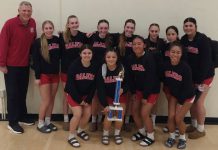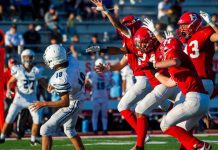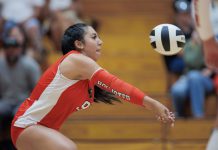How the local Mascots came to be
We’ve all seen them running around at home games trying to fire
up the crowd and drum excitement for the team they symbolize. Most
teams have them from the professional level downward to high
schools across America.
They’re funny. They clown around and ad a bit of laughter to
games that can otherwise get intense on the playing field,
especially during playoff time.
Yes they’re the mascots that symbolize the teams they
represent.
How the local Mascots came to be
We’ve all seen them running around at home games trying to fire up the crowd and drum excitement for the team they symbolize. Most teams have them from the professional level downward to high schools across America.
They’re funny. They clown around and ad a bit of laughter to games that can otherwise get intense on the playing field, especially during playoff time.
Yes they’re the mascots that symbolize the teams they represent.
At San Benito High there’s the farmer with the giant looking bobble head who’s known as the Haybaler – the only such named mascot in the nation. Gilroy High has the Mustang. Live Oak High School is the home of the Acorns and Sobrato is home to the Bulldogs.
While most think of those schools when they hear the name of the mascot, few know how that name came about.
Take the Acorns of Live Oak. Ever wonder why any home team would want to be named after a nut? Nuts are supposed to be crushed, right? They’re not supposed to do the crushing. So why name a team after a nut? Why not name it something after something strong?
But the answer is simple, and logical.
No one knows the exact date for sure but Live Oak High School, which recently celebrated its 100th birthday, was named so because the city of Morgan Hill used to be home to an abundance of Live Oak trees. And those mighty Live Oak trees just so happen to grow from a tiny acorn.
“When I first came here (1987) there was a movement to change the name,” said Live Oak Athletic Director Mark Cummins. “A lot of alumni didn’t like it and said the acorn has a history and tradition here. What I like about it is it’s a unique name. When the Spartans or Mustangs are playing it can be a lot of different schools but when the Acorns are playing, people know it’s Live Oak. And when the Acorns play the Haybalers I don’t think there’s too many match-ups like that anywhere.”
In recent years the school has added the slogan “Go Nuts!” which has accompanied the Acorns whenever they play.
In fact in the school’s gymnasium today has the words “Go Nuts” painted right on the interior wall of the building.
“I think the water polo team started the go nuts thing,” said Live Oak’s water polo coach of 20 years, Mac Haines. “But it’s become almost controversial. I’ve heard from guys who played water polo on San Jose State’s 1968 NCAA championship team that say they were the first team two use it.”
Rumor has it that the Spartans began yelling go nuts after a man, who some people think was probably the now famous San Jose State alumnus “Krazy George”, who ran across the football field at Stanford during a San Jose State vs. Stanford football game yelling “Go Nuts!” to the Spartan fans in the crowd.
Another thing that many athletes at Live Oak shout during games in recent years has been the saying “Bust a Nut,” which has raised a few eye brows of concern in recent years.
“Euphemistically, one can look at that from an anatomy standpoint or a state of being,” said Haines. “We believe that the saying means playing with intensity.”
While the Acorns are looking to bust a nut the opposition is looking to crush the nuts.
“We’ve seen a lot of crush the nuts signs over the years, but it’s all in fun,” said Cummins.
Although San Benito County was known for its fruit trees and fields of flowers and crops, the Haybaler name came to be at the turn of the 20th Century when Hollister held the distinction of storing more hay than any other city in the world. One warehouse alone during the period held 35,000 tons of it.
As the city began to ship its hay all along the West Coast, Hollister became known as “Hay City.”
Soon “Hay City” had a football team at the high school that began playing in the 1920s. Prior to that time period most schools didn’t need to have a mascot since horse and buggies weren’t very conducive to road games and sports were often played intramurally. But that all changed in the roaring ’20s.
Back then, the Hollister football players were named the Huskies, not after the breed of dogs, but because the team was full of big farm boys. The name never stuck as locals and outsiders both considered the boys from Hay City as hay balers and that’s the name that caught on.
In the same way all of the surrounding teams were linked to their farming heritage. People from Watsonville were apple pickers and people from Gilroy were prune, not garlic, pickers. In time that all changed although vestiges remain. The annual football game between Hollister and Gilroy came to be known as the Prune Bowl.
Although no one knows for sure, it’s an educated guess that Gilroy High sports teams came to be known as the Mustangs sometime in the 1930s despite the fact that Gilroy High’s first graduating class was in 1876.
“I’m guessing that maybe the gymkhana and old rodeo grounds that were near the South Valley Middle School (site of old high school) has something to do with it,” said Gilroy High Athletic Director Jack Daley.
“There were no wild horses here, not at all,” said Gilroy Historical Society Museum Assistant Tom Howard. “My guess is that they wanted to chose something that was wild and strong. It was probably as simple as that.”
In looking for old references to the Mustangs, Howard discovered the name in the school’s 1940 yearbook, but believes the name may have started before that.
Since Sobrato High is a mere two years old, it’s easy to delve into why the school was named after the Bulldogs.
“The kids voted on it and that’s all that happened. They chose the name,” said Sobrato Athletic Director Dennis Martin.
Over the years the costume or uniforms of the local team mascots have changed somewhat. Most have become more elaborate.
For example, the giant Acorn costume that one “lucky” Live Oak student gets to wear at big games cost roughly $3,000. It has a fan inside it to keep the wearer cool. The only problem with the new Acorn is that it’s too heavy for most females to wear, according to the school’s Associated Student Body President Norm Dow, who along with Live Oak alumni Wesley LaPorte was instrumental in getting the upgraded costume to the school two years ago.
“It’s really heavy – too heavy for the girls. In fact, we had a girl faint in it who wore it at a rally a year ago,” said Dow. “She got real lightheaded in it. It’s very hot in there and very claustrophobic.”
Live Oak’s Acorn is the most modern and high-tech when compared with the other mascot costumes, but they’re all equally as hot inside.
“Ours is a little heavy and it gets hot in there too,” said Daley. “But there’s always some kid who wants to put it on. Sometimes, one person wears it the whole year. Other times we rotate it through.”
Whatever the case, the high school mascot is a tradition that will continue for as long as games are played.









